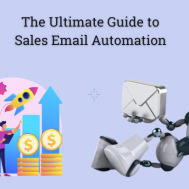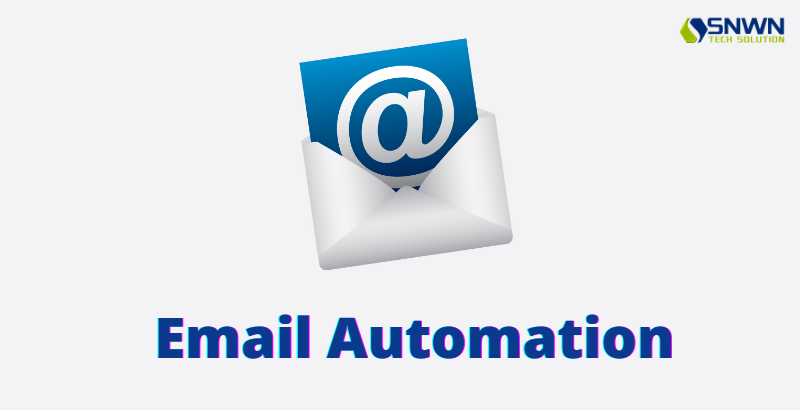Mankind has come a long way in history and so has technology. With these advancements in technology so too has sales techniques & strategies, campaigns and tools have also changed drastically over the ages and continue to do so.
Now as we step into the second decade of the 21st century, sales techniques and tools are once again undergoing upgradation; this time with the Ultimate Guide to Sales Email Automation.
Automation has been spreading like wildfire sometime now. In this article we will try to understand everything there is to about Sales Email Automation as simply as possible.
Sales Automation
To understand Sales Email Automation, one needs to understand two things first Sales Automation and Email Automation.
So what is Sales Automation?
As you can understand from the word automation, we are talking about automation software. But then how are they relevant to sales? Well, let’s take two cases:
Case1:
Let’s say you are the Sales Manager of a leading sales firm. Your daily sales tasks include setting up the targets for your teams, analyzing their performances, and predicting upcoming sales potentials among many other tasks.
Case2:
Say you are a sales rep from the same company and your daily sales tasks would mainly include prospecting, retaining your existing customers, and focus on achieving your targets.
Now in both cases, there are many repetitive tasks. These tasks are quite time-consuming and most often lead to missing out on a few minor details like losing track of prospective clients.
Now, what if you could focus solely on closing more deals and outsource these tediously repetitive tasks to someone else? I’m not talking about a human; rather a software.
With so many tried and tested platforms, including Customer Relationship Management (CRM) systems and automation tools, your job can become at the same time a lot easier, smoother, and smarter. That is what we call Sales Automation software.
Why Sales Automation?
With an automated sales process, tracking leads and following-up with them becomes guaranteed to never miss out.
This is because with automated communication you will keep getting reminders about your follow-up schedules and this makes sure that you don’t miss out on the task.
For many newcomers, getting to fully understand how the sales process works and how to identify the shortcomings in one’s sales process becomes a nightmare.
The most asked question is “why do my leads never lead to conversion?” With a fully automated sales pipeline, you can easily track and identify the stages where you are losing most of your clients.
Another leading problem becomes identifying and understanding the source of your leads and clients.
Without fully understanding where the lead is entering your pipeline from, you cannot understand your target audience and this will pose a problem to strategize a better sales campaign. With automation tools, this becomes very easy.
Sales Process Automation
The sales process of your sales teams is an important asset to your business. With a well-defined sales process, you can take on your sales campaigns effectively.
With automation, you can further improve the efficiency of the existing sales process by identifying the loopholes and cracks and improving them.
Thus Sales Process Automation can be defined as the process of automating the various steps and tasks in your existing sales process, so that the sales reps can focus more on connecting with prospects and selling to your customers, without having to worry about the various administrative tasks.
With these process automation tools, you can enjoy a much more streamlined workflow. One such software is particularly very important: the Customer Relationship Management (CRM) tool.
This is so because the CRM tool acts as the center of the wheel holding onto the various spokes.
Without a proper CRM tool, you cannot effectively carry out other automation tools. The CRM tool can help automate these following key tasks in your daily sales process:
- Prospecting
- Lead Enrichment and Rotation
- Lead Scoring and qualifying prospects
- Daily Follow-ups
- Deal Management
- Reporting and Dashboards
Email Automation
In 2020, we have many different forms of sales tools and email is one of them. With the improvements in technology, some might think that the age of emails is coming to an end.
But the scenario is quite different. According to a US-based survey, about 95% of online consumers from the country use emails as the preferred mode of communication.
The survey also shows us some figures that highly suggest that email is far from being ‘taken over’. According to them, about 2.8 mil emails are sent every second with around 43.5 mil consumers checking their emails daily.
This has paved the way for email automation. It is an automated emailing option where the right emails are sent to the right people at the right time.
That too without having to do it yourself! The main aim of email automation like any other sales process automation is to nurture leads into customers.
But how exactly does it work?
There are many email automation tools in the market and each of them has its own working methods with their own UI. However, the general working principle can be chalked out as follows:
- A random person visits the website of company XYZ and completes certain actions like filling out a form or downloading an eBook.
2. The contact information of this person is automatically added to the marketing database of that company.
3. Based on the location, preferences, behavior, etc criteria, these gathered data are segmented into different audience segments.
4. Next, the marketing teams will create a campaign depending upon these leads and data by setting up trigger points to schedule when and to whom the emails will be sent automatically.
5. The person(s) visiting the website will receive emails depending on the conditions and trigger points set by the marketing teams.
Benefits of Email Automation
Email automation can help your sales and marketing campaigns in a much smarter way:
- It works on its own and all you need to do is set up the criteria or checkpoints to guide the automation process.
2. It helps you understand the best time for your sales team to contact leads by following up with their interests as not every lead might be your prospective client(s).
3. Studies show that 90% of consumers find personalized content much more appealing and with email automation tools you can do just that as you can target their interest because the tool helps you nurture your leads too.
4. As the whole process is automated you can save up a lot of time that you can focus on other tasks and outsource these repetitive tasks to your AI friend.
5. With email automation, the need for a large sales team making daily cold calls becomes very less important and so you can cut back a lot on your investment costs. In turn, your reps can contact the leads at the right time.
Sales automation tools are becoming more and more imperative as we go forward in this age of technology.
With so many cool time-saving processes your reps can focus on what really matters and leave the administrative tasks to AI. This helps businesses make time from otherwise repetitive tasks that bog them down.
ALSO READ : Personalize Outreach at Scale with Sales Engagement Automation
So get started with your sales and email automation tools and lead your business from a simple startup to one of the leading brands in the market.

